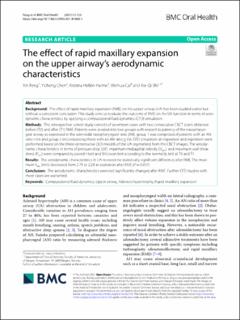The effect of rapid maxillary expansion on the upper airway’s aerodynamic characteristics
Journal article, Peer reviewed
Published version

Åpne
Permanent lenke
https://hdl.handle.net/11250/2989144Utgivelsesdato
2021Metadata
Vis full innførselSamlinger
- Department of Clinical Dentistry [479]
- Registrations from Cristin [10412]
Sammendrag
Background
The effect of rapid maxillary expansion (RME) on the upper airway (UA) has been studied earlier but without a consistent conclusion. This study aims to evaluate the outcome of RME on the UA function in terms of aerodynamic characteristics by applying a computational fluid dynamics (CFD) simulation.
Methods
This retrospective cohort study consists of seventeen cases with two consecutive CBCT scans obtained before (T0) and after (T1) RME. Patients were divided into two groups with respect to patency of the nasopharyngeal airway as expressed in the adenoidal nasopharyngeal ratio (AN): group 1 was comprised of patients with an AN ratio < 0.6 and group 2 encompassing those with an AN ratio ≥ 0.6. CFD simulation at inspiration and expiration were performed based on the three-dimensional (3D) models of the UA segmented from the CBCT images. The aerodynamic characteristics in terms of pressure drop (ΔP), maximum midsagittal velocity (Vms), and maximum wall shear stress (Pws) were compared by paired t-test and Wilcoxon test according to the normality test at T0 and T1.
Results
The aerodynamic characteristics in UA revealed no statistically significant difference after RME. The maximum Vms (m/s) decreased from 2.79 to 2.28 at expiration after RME (P = 0.057).
Conclusion
The aerodynamic characteristics were not significantly changed after RME. Further CFD studies with more cases are warranted.
